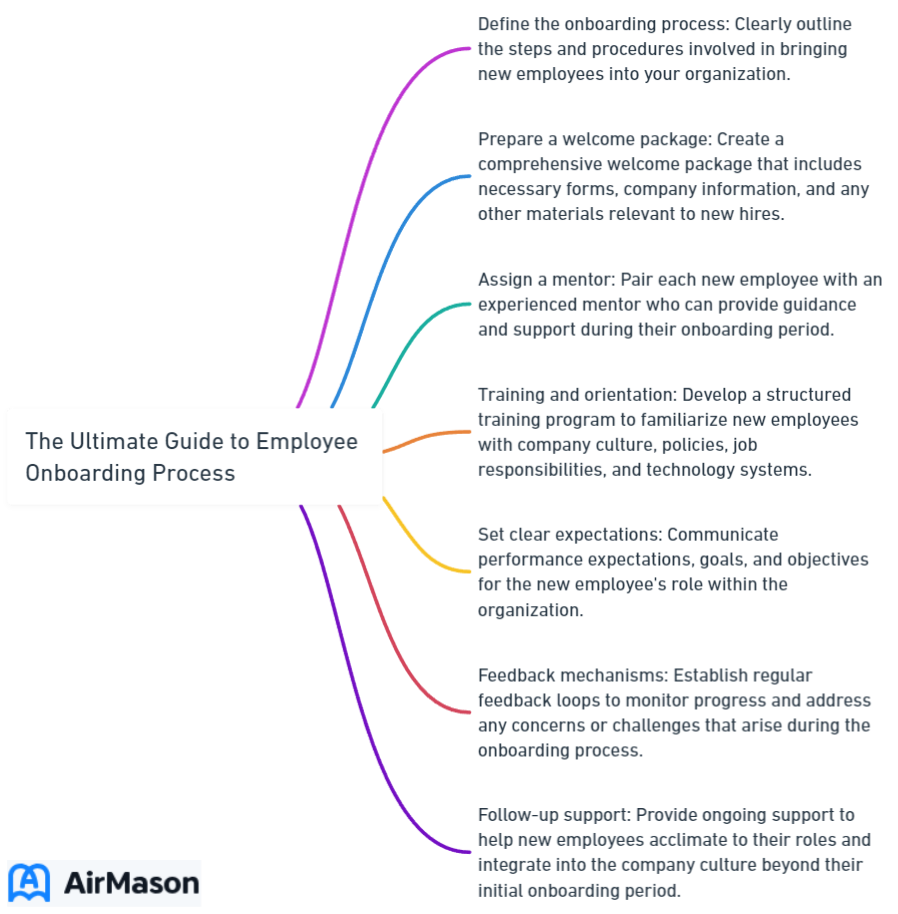![The Ultimate Guide to Employee Onboarding Process [2023] (1)](https://images.blog.airmason.com/wp-content/uploads/2023/10/The-Ultimate-Guide-to-Employee-Onboarding-Process-2023-1.png)
Are you struggling with employees leaving your company shortly after joining, or taking too long to become productive? The solution might be a well-structured and effective onboarding process. In this blog post, we’ll dive deep into the employee onboarding process, explore its key components, discuss the role of HR, and offer practical tips to ensure a successful onboarding experience for your employees.
Key Takeaways
- Understanding the employee onboarding process involves creating an efficient experience that leads to better retention and performance.
- An effective onboarding process is comprised of pre-boarding activities, first day essentials, and ongoing support & development.
- HR professionals can use solutions to overcome common challenges in order to create a positive onboarding experience for remote employees.
Understanding the Employee Onboarding Process
A good employee onboarding process is more than just paperwork and basic orientation. It’s an entire process that starts before the employee joins the company and extends throughout their initial months of employment. An effective onboarding process helps new employees assimilate into the company’s culture, understand their roles, and receive on-the-job training, ultimately leading to employee satisfaction and long-term success.
The duration of the onboarding process may differ based on the company and the employee’s role. However, bear in mind that a new employee’s onboarding experience can significantly affect their performance and satisfaction. Both the new employee’s manager and the HR team should be involved in creating an efficient onboarding experience, one that spans from the prospective employee’s initial interaction with the company to their integration into the team and company’s processes.
A poor onboarding experience can lead to confusion, frustration, and even employee turnover, which is expensive and time-consuming for businesses. On the other hand, a good onboarding process sets clear expectations for the new hire, promotes open communication, and fosters a sense of belonging, ultimately leading to better employee retention and performance.

Key Components of an Effective Onboarding Process
A successful employee onboarding process involves three main components: pre-boarding activities, first-day essentials, and ongoing support and development. By following a comprehensive onboarding checklist, these components work together to create a positive onboarding experience that helps new employees feel welcomed and valued, while also ensuring they have the tools and resources needed to become productive members of the team.
Employee Onboarding
Employee onboarding is a critical process that sets the tone for a new hire’s experience within an organization. It encompasses the structured orientation and integration of a new employee into the company culture, policies, and their role responsibilities. A well-planned onboarding program not only familiarizes the employee with their job duties but also helps them understand the broader organizational goals and values. This process typically includes elements such as orientation sessions, introductions to key team members, training programs, and provision of necessary resources. Effective employee onboarding not only leads to quicker productivity but also fosters a sense of belonging and engagement, ultimately contributing to higher retention rates and overall organizational success. It’s a strategic investment in the long-term success of both the individual and the company.
Pre-Boarding Activities
Pre-boarding is the preparatory phase before a new hire’s first day of employment. It is an essential part of the employee onboarding process, as it helps facilitate a smoother transition for the employee when they join the company. Pre-boarding activities typically include sending welcome emails, providing company policies, and assigning tasks. A pre-boarding email should be accurately structured to include all crucial information related to the activity. Examples of such details may include dates, times, locations, contact info, instructions on what to bring and dress code. This email should be concise and pre-formulated to ensure consistency and clarity.
Beyond emails, there are several measures that can be taken prior to the new hire’s first day to ensure a smooth and welcoming transition. These include:
- Constructing an orientation agenda
- Establishing their salary account
- Furnishing the essential office supplies
- Appointing a mentor to assist the new hire in acclimating
- Allocating IT resources to the employee
- Providing basic training materials and an outline of the tasks to be accomplished via employee onboarding software
Proactive preparation for a new hire’s arrival by HR managers can pave the way for a successful onboarding experience, leaving a lasting, positive impression on the employee.
First-Day Essentials
The first day of work signifies a vital stage in a new employee’s onboarding journey. Crafting a memorable onboarding experience can make them feel welcomed, valued, and ready to excel in their new role. To achieve this, a combination of practical and engagement-focused activities should be planned for the first day.
Practical activities include providing employees with necessary hardware and software, having them sign relevant paperwork, and giving them a tour of the office. On the other hand, engagement-focused activities can involve ensuring clear communication, setting expectations, introducing new hires to the company culture and values, and facilitating their connection with colleagues and integration into the team.
Another key aspect of making a new employee’s first day successful is ensuring they have a clear agenda and know what to expect. Involvement of the new hire’s manager in the process can contribute to a memorable and positive experience on the first day of onboarding, given their significant role in the employee’s success.
Ongoing Support and Development
Although the initial days of onboarding set the tone for a new employee’s experience, providing ongoing support and development throughout their tenure is equally vital. Sustained support during the onboarding process can lead to enhanced performance, job satisfaction, and employee retention. This support may come in the form of on-the-job training, mentorship, and regular feedback from the employee’s manager.
Training plays an integral role in the onboarding process, helping new employees understand their roles and responsibilities and reducing the need for excessive hire paperwork. The success of training implementation largely depends on the support of the employee’s immediate manager, who should be actively involved in the process.
Additionally, a designated mentor or colleague can provide support and guidance to help the new employee acclimate to their new environment. This ongoing support, combined with a culture of open communication and regular feedback, can foster a sense of belonging and connection among employees, as well as augment employee engagement and productivity.
The Role of HR in Employee Onboarding

The human resources (HR) department is instrumental in the employee onboarding process, with responsibilities including:
- Issuing job offers
- Coordinating with other departments
- Offering training and orientation
- Providing the employee handbook
- Managing the entire onboarding workflow
- Ensuring that all required steps are completed promptly and efficiently.
Collaboration with other departments during the onboarding process is vital, benefiting both the department in which the individual will function and the departments they will coordinate with. This coordination ensures that all necessary information is shared, and resources are allocated effectively. During the onboarding process, HR generalists and the IT team may work together to provide HR orientations and equipment set-up, ensuring that employees have the tools they need to succeed in their new roles.
In addition to coordinating onboarding activities, HR is also responsible for managing the transition of current employees into new roles, a process known as crossboarding. By providing support and guidance during this transition, HR professionals can help ensure a smooth and successful experience for employees moving to new positions within the company.
What is Onboarding
“What is onboarding” is a critical process in the realm of human resources and organizational development. It refers to the structured approach taken by companies to integrate and orientate new employees into the workplace environment. This process encompasses a series of activities designed to familiarize newcomers with their roles, team members, and the company’s culture and policies. Effective onboarding not only provides essential information about job responsibilities but also sets the foundation for a positive employee experience. It typically involves a mix of formal training sessions, introductions to key personnel, and the distribution of relevant materials. Additionally, onboarding serves as a platform for establishing clear performance expectations and addressing any initial concerns or questions that new hires may have.
Benefits of a Well-Structured Onboarding Process
A well-structured onboarding process offers numerous benefits, including improved employee retention, faster time to productivity, and increased job satisfaction. By taking the time to create a comprehensive and effective onboarding process, companies can help new employees feel welcomed, supported, and prepared to contribute to the organization’s success.
One of the primary advantages of a well-structured onboarding program is enhanced employee retention. Employees who undergo a positive onboarding experience are more likely to stay with the company for longer periods. This can lead to cost savings for the organization, as hiring and training new employees can be a significant expense.
Another benefit of a well-planned onboarding process is the faster time to productivity. By providing new employees with the necessary tools, resources, and training, companies can help them quickly become productive contributors to the organization. This increased productivity can lead to improved overall performance and success for the company.
Implementing Technology in Onboarding
Leveraging technology in the employee onboarding process can streamline and enrich the experience for both employees and HR professionals. Incorporating technology, such as HR software and chatbots, can reduce the burden on HR personnel while providing new employees with a stimulating and optimized experience.
HR software, such as Hibobs, Boardon, and Freshteam, can be employed to automate tasks, track progress, and provide personalized onboarding experiences for each new hire. By utilizing onboarding software, HR managers can ensure that all required steps are completed promptly and efficiently, allowing them to focus on more strategic aspects of their role.
Chatbots can also play a significant role in the employee onboarding experience. They can be utilized to address employee inquiries and provide guidance during the onboarding process. For example, chatbots can be programmed to answer questions about company policies, helping new employees quickly become familiar with the organization’s processes and expectations.
Best Practices for Successful Employee Onboarding
For a successful employee onboarding process, adherence to best practices and implementation of strategies that welcome, support, and prepare new hires for success is necessary. Some of these best practices include:
- Aligning job descriptions with the actual roles and responsibilities of the position, ensuring clear expectations for new employees.
- Automating workflows and tasks within the onboarding process, reducing the administrative burden on HR personnel and ensuring all required steps are completed efficiently.
- Fostering a strong company culture that promotes open communication, collaboration, and a sense of belonging, helping new employees feel connected and engaged with the organization.
By implementing these best practices, companies can create an effective onboarding process that not only attracts and retains top talent but also helps new employees become productive members of the team.
Overcoming Common Challenges in Onboarding
Even with the best efforts of HR professionals, common challenges can surface during the onboarding process. Some of these challenges include:
- An abundance of paperwork
- A lack of understanding of roles and responsibilities
- An overload of information
- Expectations that may be difficult to meet
However, there are solutions to overcome these obstacles and create a positive onboarding experience.
To address role clarity, it’s crucial to:
- Clearly define and communicate the responsibilities and tasks associated with the role
- Provide a written schedule or timeline that outlines expectations and deadlines
- Encourage open communication and provide opportunities for new hires to ask questions and seek clarification.
To avoid information overload, consider drip-feeding necessary and relevant information gradually instead of overwhelming the employee with all the information at once. Present content in bite-size bits to facilitate easier digestion and retention of the information. Include only essential information during the first day on the job and share additional information over time as needed.
Measuring the Success of Your Onboarding Process
Tracking onboarding metrics is vital to assess and enhance the employee onboarding process. Metrics such as turnover rate, satisfaction, and training completion can provide valuable insights into the effectiveness of the onboarding process and help identify areas that may need optimization or revision.
By gathering feedback from new employees and analyzing the data, HR professionals can gain a better understanding of the onboarding experience and make necessary adjustments. Feedback scores from both new hires and managers can also be used as a key metric to evaluate the effectiveness of the onboarding process.
By correlating onboarding metrics and constructive 360 feedback, employees can recognize any additional training or support they may require for a successful onboarding experience. This continuous improvement approach ensures that the onboarding process remains effective and relevant, ultimately leading to better employee retention and performance.
Onboarding Employee Experience
The onboarding employee experience plays a pivotal role in setting the tone for a new hire’s journey within an organization. It encompasses the entire process of integrating a new team member, from the moment they accept the job offer to their first few months on the job. A well-structured onboarding program goes beyond administrative tasks; it provides a comprehensive introduction to the company culture, values, and expectations. This experience is designed to acclimate employees to their roles, foster a sense of belonging, and ensure they have the tools and knowledge needed to excel in their positions. Effective onboarding not only boosts productivity but also contributes to higher retention rates and increased job satisfaction. It is a crucial step towards building a motivated and engaged workforce, ultimately leading to organizational success.
Adapting the Onboarding Process for Remote Employees

With the prevalence of remote work, adapting the onboarding process to cater to remote employees becomes a necessity. Leveraging technology, maintaining clear communication, and fostering a sense of belonging and connection are crucial strategies for ensuring a successful onboarding experience for remote workers.
Technology such as:
- Video conferencing software
- Onboarding software
- Intranet
- Learning management systems (LMS)
- HR systems
- Communication tools
- Chatbots
- Digital forms and documentation
- Online training platforms
- Virtual tours
can be utilized to provide a streamlined and engaging remote onboarding experience.
Setting clear expectations and communication guidelines, establishing distinct lines of communication, and emphasizing the resources available to the employees are essential for effective communication with remote employees during onboarding. Providing regular feedback and recognition, and ensuring that remote employees are included in team activities can also help foster a sense of belonging and connection.
Summary
In conclusion, a well-structured and effective employee onboarding process is essential for ensuring employee satisfaction, retention, and productivity. By understanding the key components of onboarding, leveraging technology, implementing best practices, and adapting the process for remote employees, companies can create a positive onboarding experience that sets new hires up for success. As the workforce continues to evolve, it’s crucial for organizations to continually evaluate and improve their onboarding processes to attract and retain top talent.
Frequently Asked Questions
What is the 4 step onboarding process?
The four-step onboarding process includes pre-boarding, orientation, training and integration, with eloomi providing customizable solutions for each phase to help new employees have a successful transition.
What is the onboarding process in HR?
Onboarding is an important HR process that helps new employees integrate into the organization. It includes activities such as completing administrative tasks, participating in a first-day orientation, learning about the organization’s structure, and understanding its culture, vision, mission, and values.
What are the 5 C’s of onboarding?
The 5 C’s of onboarding are compliance, clarification, confidence, connection, and culture – all essential components to ensure a successful and smooth onboarding experience.
How many days is onboarding?
Onboarding typically should take at least three months, with some HR experts recommending up to six months of onboarding for new hires. Extending the onboarding process throughout the employee’s first year can positively increase employee retention and engagement.
How long should the employee onboarding process last?
The employee onboarding process typically lasts for several months.

